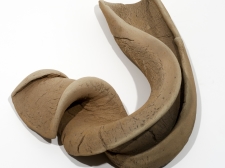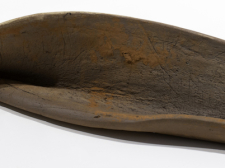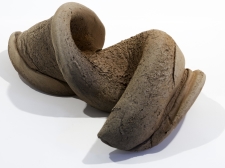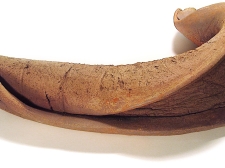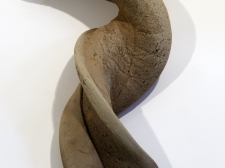 Rudolph Serra
Rudolph Serra
EARLY IMPRESSIONS
California — its landscape is like no other. Growing up in San Francisco near the ocean, early impressions were made by the harsh weather’s impact on the long stretch of beach nearby. Always in flux, nature left its strong, calming, soothing imprint. The beach would change from a large, horizontal plane to high dunes, to deep tidal pools carved by the backwash of rip currents. Mountains — rugged and steep, separated by long, wide valleys carved by earthquake faults, existed here differently than in any other place on earth. Deserts — barren, harsh, and nearly lifeless, yet incredibly beautiful, became a backdrop before which I realized both the significance and insignificance of my existence.
ARTIST INFLUENCES
During my early, formative years, the sculptures of our neighbor two doors away — Mark de Suvero — and later those of my older brother — Richard Serra — were impressive, and easy to mimic and emulate. Their sculptures seemed to be built with a kind of dynamic, architectural presence. This offered a language for me to use to construct forms. Yet later, Peter Voulkos was the most influential artist that I would encounter. While I was a graduate student at University of California at Berkeley, I witnessed Voulkos’ assault on what was then the field of ceramics and pottery. This made a great impression on me. Without question, Voulkos was the best artist, and worst teacher, that I had ever met. Although his work was dependent upon cylindrical forms derived from throwing clay on a potter’s wheel, Voulkos’ assertiveness and aggressiveness toward the clay surface and texture was raw, fresh, and seemingly free. This freedom reflected the work of other artists of his generation — the abstract expressionists.
WHY CLAY?
Early in my career, it seemed to me that each material and method of construction, had its constrictions. Welding, as an example, seemed to lead to a putting together of parts into a compositional whole, while casting dictated the replication of a form. Carving prescribed working in a subtractive mode, and a potter’s wheel mandated a cylindrical form. I wanted to find a way to shape, form, and “draw” without a preset of confines. Malleable materials, which I began to work with — plaster, concrete, and asphalt — seemed to have more potential. I returned to clay. But I wanted nothing to do with the traditional history of clay: cylindrical forms, glossy glazed surfaces, or sculpted images.
TERRA COTTA WORKS
These terra cotta reliefs are the direct outcome — the residue and evidence — of the processes that the clay has been subjected to. They also are, in a sense, three-dimensional drawings. My intention is that the viewer first sees each object’s parameter, and then follows the “drawing” of the gestural folds, edges, crevices, ravines, and gouges that make up the curving contours of each work. The surface coloring, caused by firing the clay at extreme high temperature oxygen-reduction, almost appears to be airbrushed. It is the result of the clay body’s inherent qualities that have been drawn to the surface from within. Although they may appear rough, raw and harsh, the sculptures emit a sense of serenity. They are closer to the shapes and textures of the natural landscape than they are to any western historical works of art.
“From a block of clay, forms have become organic and alive.”
2016 –“HANDMADE: Rudolph Serra & Anna Strickland,” Christian Duvernois Gallery, New York, NY
2013 –The Center for Contemporary Art, Bedminster, NJ
2007 –Art Sites Gallery, Riverhead, NY
2000 –Commission, Wall Relief, Muhlenberg College, Allentown, PA
1997 –“Rudolph Serra & Mark Di Suvero,” Frank Martin Gallery, Muhlenberg College, Allentown, PA
1992 –Haenah Kent Gallery, New York, NY
1990 –John Davis Gallery, New York, NY
1987 –Kenmare Square, New York, NY
1985 –Outdoor Sculpture, Nassau Museum, Nassau, NY
1983 –Marianne Deson Gallery, Chicago, IL
1982 –Baruch College, New York, NY
1980 –University of Houston, Houston, TX
2016 – American Academy of Arts and Letters, New York, NY
2014 – Ille Arts, Amagansett, NY
2014 –Comisionado Dominicano de Cultura, New York, NY
2013 –Center for Contemporary Art, Bedminster, NJ
2012 –MANA Contemporary, Jersey City, NJ
2011 – Cavin Morris Gallery, New York, NY
2010 –Dacia Gallery, New York, NY
2009 –Ernest Rubenstein Gallery, New York, NY
2009 – “Sculpture & Photography,” Benson-Keyes Arts, Southampton, NY
2008 –“Masters in Clay,” Grounds for Sculpture, Hamilton, NJ
2007 –“Rudolph Serra, Peter Voulkos, Toshiko Takaezu,” Charles Cowles Gallery, New York, NY
2005 –Faculty-Graduate Exhibition, Rutgers University, New Brunswick, NJ
2004 – Inaugural Exhibition, The Shore Institute of Contemporary Arts, Long Branch, NJ
2004 –Flemming Museum, Burlington, VT
2001 –Youngblood Gallery, Sag Harbor, NY
1999 –New Acquisitions, Frank Martin Gallery, Muhlenberg College, Allentown, PA
1998 –O.K. Harris Gallery, New York, NY
1998 –Mt. Desert Island, Maine, The Fabric Workshop, Philadelphia, PA
1995 –Art in General Gallery, New York, NY
1993 –The Drawing Center, New York, NY
1992 – Rosa Esman Gallery, New York, NY
1990 – “Expressionistic Surface,” The Queens Museum, Queens, NY
1989 – “Microsculpture,” Art Department, University of Rhode Island, RI
1988 –“The Cube Exhibition,” University of Massachusetts, Amherst, MA
1987 –Socrates Sculpture Park, Long Island City, NY
1987 –Faculty Exhibition, Sarah Lawrence College
1983 – International Sculpture Exhibition, The Oakland Museum, Oakland, CA
1981 –Faculty Exhibition, Benton Museum, University of Connecticut,
1980 –Artists in Residence, Bennington College, Bennington, VT
1979 –“Mark Di Suvero & Rudolph Serra & Bill Wareham,” Fuller Gallery, San Francisco, CA
1979 –“The Whitney Biennial,” Whitney Museum of American Art, New York, NY
2016 –American Academy of Arts and Letters
2006 – Pollock Krasner Foundation Grant
1983, 1980, 1978 –National Endowment for the Arts Grant for Sculpture
1980 –Research Grant, University Of Connecticut
The San Francisco Museum of Modern Art
University of California at Berkeley, Art Museum
Muhlenberg College
Julian Weiss & Associates Architects
The San Franciso Art Commission
Vermont Studio School



